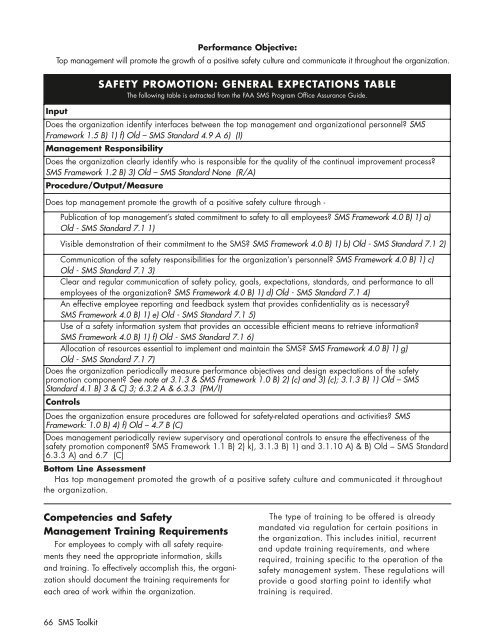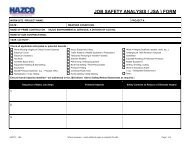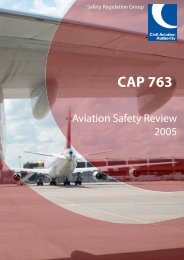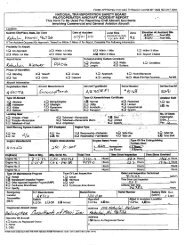International Helicopter Safety Team Safety Management System Toolkit
IHST - Safety Management Toolkit - Skybrary
IHST - Safety Management Toolkit - Skybrary
- No tags were found...
You also want an ePaper? Increase the reach of your titles
YUMPU automatically turns print PDFs into web optimized ePapers that Google loves.
Performance Objective:<br />
Top management will promote the growth of a positive safety culture and communicate it throughout the organization.<br />
SAFETY PROMOTION: GENERAL EXPECTATIONS TABLE<br />
The following table is extracted from the FAA SMS Program Office Assurance Guide.<br />
Input<br />
Does the organization identify interfaces between the top management and organizational personnel? SMS<br />
Framework 1.5 B) 1) f) Old – SMS Standard 4.9 A 6) (I)<br />
<strong>Management</strong> Responsibility<br />
Does the organization clearly identify who is responsible for the quality of the continual improvement process?<br />
SMS Framework 1.2 B) 3) Old – SMS Standard None (R/A)<br />
Procedure/Output/Measure<br />
Does top management promote the growth of a positive safety culture through -<br />
Publication of top management’s stated commitment to safety to all employees? SMS Framework 4.0 B) 1) a)<br />
Old - SMS Standard 7.1 1)<br />
Visible demonstration of their commitment to the SMS? SMS Framework 4.0 B) 1) b) Old - SMS Standard 7.1 2)<br />
Communication of the safety responsibilities for the organization’s personnel? SMS Framework 4.0 B) 1) c)<br />
Old - SMS Standard 7.1 3)<br />
Clear and regular communication of safety policy, goals, expectations, standards, and performance to all<br />
employees of the organization? SMS Framework 4.0 B) 1) d) Old - SMS Standard 7.1 4)<br />
An effective employee reporting and feedback system that provides confidentiality as is necessary?<br />
SMS Framework 4.0 B) 1) e) Old - SMS Standard 7.1 5)<br />
Use of a safety information system that provides an accessible efficient means to retrieve information?<br />
SMS Framework 4.0 B) 1) f) Old - SMS Standard 7.1 6)<br />
Allocation of resources essential to implement and maintain the SMS? SMS Framework 4.0 B) 1) g)<br />
Old - SMS Standard 7.1 7)<br />
Does the organization periodically measure performance objectives and design expectations of the safety<br />
promotion component? See note at 3.1.3 & SMS Framework 1.0 B) 2) (c) and 3) (c); 3.1.3 B) 1) Old – SMS<br />
Standard 4.1 B) 3 & C) 3; 6.3.2 A & 6.3.3 (PM/I)<br />
Controls<br />
Does the organization ensure procedures are followed for safety-related operations and activities? SMS<br />
Framework: 1.0 B) 4) f) Old – 4.7 B (C)<br />
Does management periodically review supervisory and operational controls to ensure the effectiveness of the<br />
safety promotion component? SMS Framework 1.1 B) 2) k), 3.1.3 B) 1) and 3.1.10 A) & B) Old – SMS Standard<br />
6.3.3 A) and 6.7 (C)<br />
Bottom Line Assessment<br />
Has top management promoted the growth of a positive safety culture and communicated it throughout<br />
the organization.<br />
Competencies and <strong>Safety</strong><br />
<strong>Management</strong> Training Requirements<br />
For employees to comply with all safety requirements<br />
they need the appropriate information, skills<br />
and training. To effectively accomplish this, the organization<br />
should document the training requirements for<br />
each area of work within the organization.<br />
The type of training to be offered is already<br />
mandated via regulation for certain positions in<br />
the organization. This includes initial, recurrent<br />
and update training requirements, and where<br />
required, training specific to the operation of the<br />
safety management system. These regulations will<br />
provide a good starting point to identify what<br />
training is required.<br />
66 SMS <strong>Toolkit</strong>







